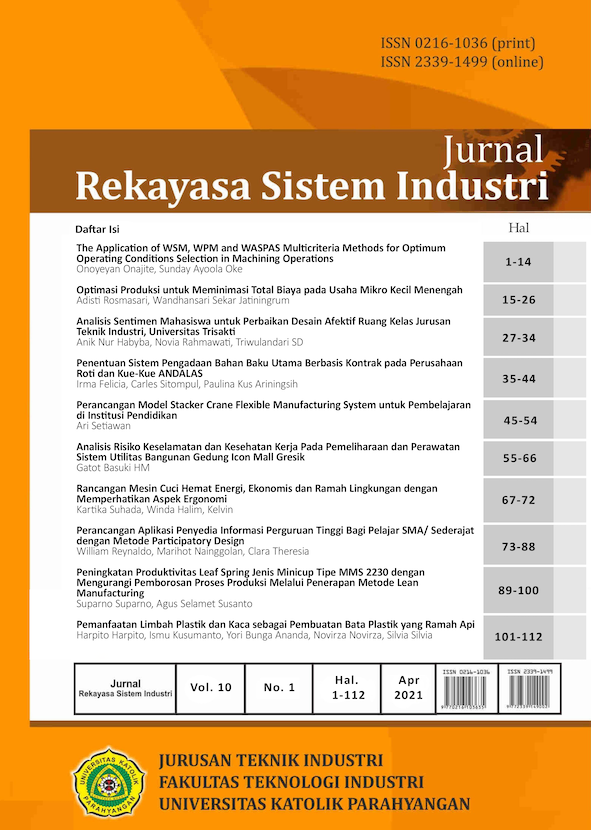Perancangan Aplikasi Penyedia Informasi Perguruan Tinggi Bagi Pelajar SMA/ Sederajat dengan Metode Participatory Design
DOI:
https://doi.org/10.26593/jrsi.v10i1.4516.73-88Abstract
Continuing study to higher education is an important thing for most of high school students, but there are still obstacles related to the information availability of higher education for high school students. These constraints can be divided into 3 categories, namely limited university information, limited department information, and limited registration information. Currently, there are university information apps, however those applications have not been able to overcome the three categories of obstacles faced. Thus, an design for application that can handle these problems. In this research, a design for application for information about higher education providers was conducted. The application design consists of 4 stages, started by determining needs using the focus group discussion method which involved 9 respondents and produced 23 needs. The second stage, determining design alternatives using the participatory design workshop method involving 8 respondents and producing 4 design alternatives, and selecting an alternative design involving 19 respondents. The third stage is making a high-fidelity prototype with the help of Adobe XD software. In the last stage, evaluation and improvement are carried out by considering the factors of usefulness, effectiveness, efficiency, learnability, and satisfaction. The result of this research is a design of application that provide information about university that meets aspects of functionality and usability. Those aspects including the usefulness factor 81.79%, the effectiveness factor 82.14%, the efficiency factor 82.14%, the learnability factor 71.43%, and the satisfaction factor 79.64%. Based on these results, this application able to use and meets user needs.
References
Afiyanti, Y. (2008). Focus Group Discussion (Diskusi Kelompok Terfokus) Sebagai Metode Pengumpulan Data Penelitian Kualitatif. Keperawatan Indonesia, 58-62.
Brooke, J. (2013). SUS: A Retrospective. JUS Journal Of Usability Studies, 29-40.
Demirbilek, O. (1999). Involving The Elderly In The Design Process: a Participatoy Design Model For Usability Safety and Attractivenss.
Jordan, W. P. (2000). designing Pleasurable products: an introduction to the new human factor. London: Taylor & Francis Books Ltd.
Marthasari , G. I., & Hayatin, N. (2017). Analisis Usability Terhadap Sistem Lective Gegulang Berbasis USE Questionnaire. Seminar Nasional Teknologi dan Rekayasa (Sentra) 2017.
Moran, K. (2019, Desember 1). Usability Testing 101. Diunduh dari Nielsen Norman Group: https://www.nngroup.com/articles/usability-testing-101/
Paramita, A., & Kristiana, L. (2013). Teknik Focus Group Discussion Dalam Penelitian Kualitatif (Focus Group Discussion Tehnique in Qualitative Reseach). Buletin Penelitian Sistem Kesehatan, 117-127.
Preece, J., Sharp, H., & Rogers, Y. (2015). Interaction Design: Beyond Human-Computer Interaction 4th ed. United Kingdom: John Wiley & Sons Ltd.
Rubin, J., & Chisnell, D. (2008). Handbook of Usability Testing 2nd Ed. Canada: Wiley Publishing INC.
Sakai, T., Okuyama, J., Arai, N., Nakamura, Y., Tsuji, T., Moriya, K., . . . Hishiyama, R. (2012). Field Informatics. In T. Ishida, Filend Informatics (pp. 123-133). Kyoto: Springer-Verlag Berlin Heidelberg.
Sekaran, U. (2010). Research Methods for Business. Chichester: John Wiley & Sons.
Sudarwati, W., & Tikwalau, D. E. (2014). Faktor-Faktor yang Mempengaruhi Siswa-Siswa SMU/ SMK Terhadap Keputusan Pemilihan Perguruan Tinggi Swasta.
Sutalaksana, I. Z., Anggawisastra, & Tjakraatmadja. (2016). Teknik Tata Cara Kerja. Bandung: Laboratorium Tata Cara Kerja & Ergonomi, Departemen Teknik Industri ITB.
Thomas, N. (2013). How To Use The System Usability Scale (SUS) To Evaluate The Usability Of Your Website. Diunduh dari UsabilityGeek: https://usabilitygeek.com/how-to-use-the-system-usability-scale-sus-to-evaluate-the-usability-of-your-website/

